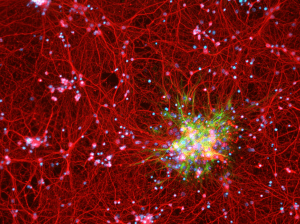By Ed Buckser

Neural Map Picture: By Dchordpdx – Own work, CC BY 4.0, https://commons.wikimedia.org/w/index.php?curid=64427063
The spinal cord is one of the human body’s most vital components. It is responsible for the neural processes that facilitate motion and sensation. If it is injured, paralysis and numbness may follow. Historically, spinal cord injuries have been among the most difficult to treat due to their severity; however, scientists at the University of California, San Diego have recently released promising research that may be a major milestone towards consistent treatment for spinal cord injuries.
The key to such treatments lies in human pluripotent stem cells (hPSCs), a type of cell that can assume a variety of different roles in the body, including transforming into neurons. When a significant number of spinal cord neurons (NSCs) are destroyed through injury or disease, they normally do not regenerate, resulting in long-term damage to the body. hPSCs can serve as a replacement for destroyed NSCs, repairing the spinal cord manually (1).
UCSD researchers illustrated that this method was effective by grafting stem cells into the spinal cords of injured rats, who showed significantly enhanced recovery relative to control groups following the procedure. The stem cells replaced several types of damaged tissue, including both motor and sensory neurons, as well as supporting glial cells that provide structural support to the nervous system (2).
One of the most difficult problems that has historically posed difficulties in stem cell research is the maintenance of stem cell cultures in laboratory settings. The UCSD researchers were able to preserve stem cells in petri dishes by using embryonic cultures and subsequently graft these cells into injured subjects with similar effectiveness to the stem cells that were not held in culture first (2).
While the technique has not yet been tested on humans, UCSD researchers predict that human trials will be a viable option within a three to five years. The main concern that needs to be addressed before human trials can begin is whether or not the grafted cells will remain effective over long periods of time.
Until then, the UCSD results have the potential to benefit other spinal cord treatment research. Lab-grown NSCs can simulate spinal cord tissue, and thus be experimented upon without the need for living test subjects.
References:
- Kumamaru, H., Kadoya, K., Adler, A. F., Takashima, Y., Graham, L., Coppola, G., & Tuszynski, M. H. (2018). Generation and post-injury integration of human spinal cord neural stem cells. Nature methods, 15(9), 723.
- University of California – San Diego. (2018, August 6). Created line of spinal cord neural stem cells shows diverse promise. ScienceDaily. Retrieved September 23, 2018 from www.sciencedaily.com/releases/2018/08/180806162716.htm

Leave a Reply